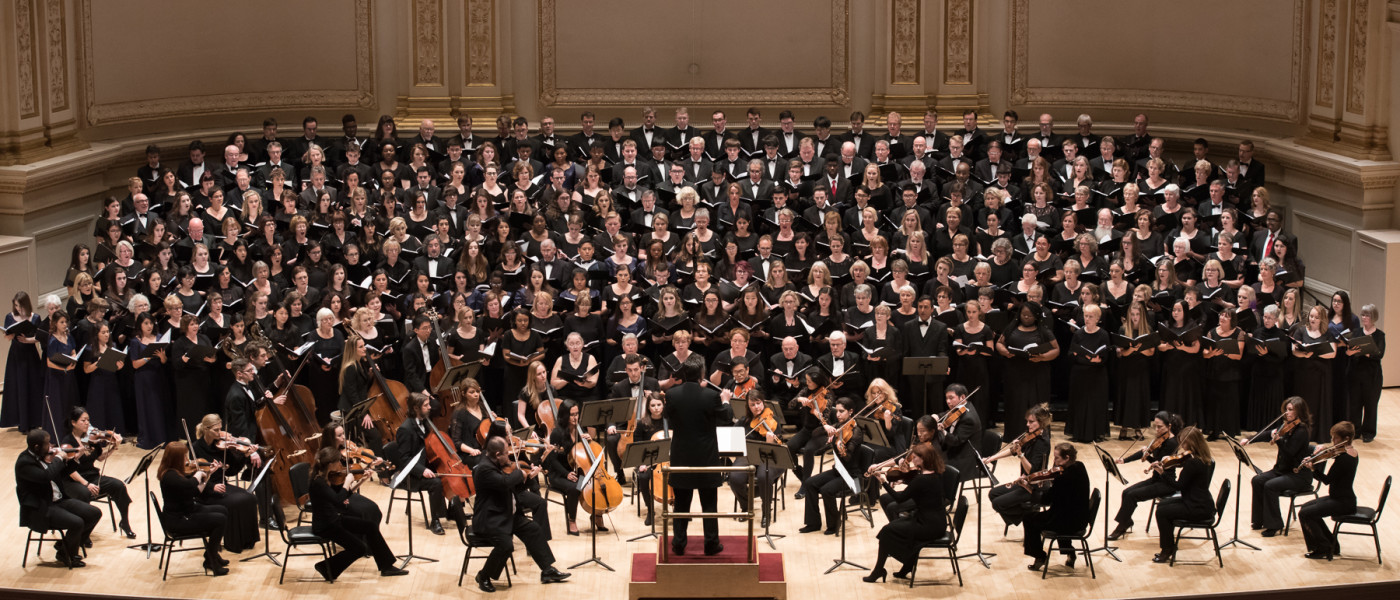Distinguished Concerts International New York (DCINY) presents Between Heaven and Earth in Review
Distinguished Concerts International New York (DCINY) presents Between Heaven and Earth
Distinguished Concerts Orchestra and Distinguished Concerts Singers International
James M. Meaders, DCINY Associate Artistic Director and Conductor, Tom Shelton, Guest Conductor, Richard Sparks, Guest Conductor
Jolaine Kerley, soprano; Timothy J. Anderson, narrator
Stern Auditorium at Carnegie Hall, New York, NY
March 7, 2016
The massed-choir events presented by Distinguished Concerts International New York (DCINY) generally have a very high level of music making and popular success. Monday’s concert was quite a mixed-bag, gathered under the title mentioned above. The singers come from eight states and six foreign countries and are prepared by their individual local conductors before traveling to New York to combine with many other choirs.
The first one-third of the evening was devoted to seven selections for a huge youth choir, containing all age groups from small boys up to high schoolers. They were led efficiently by Tom Shelton, who also made some of the rather slick arrangements. The selections were not performed in the order listed on the program, and one was left out entirely. Perhaps I shouldn’t evaluate this performance with the same rigor I would apply to a professional choir. Surprisingly, the enormous group had trouble actually projecting, except when the vocal writing allowed the voices to soar to higher notes, where one could enjoy the characteristic gleam of such an age-group. The repertoire extended from modern sacred, to Baroque, folk-inspired (Stephen Hatfield’s moving Family Tree), even Italian madrigal. The exciting Ritmo by Dan Davison involved not only singing, but clapping, stomping, finger-snaps, chest thumps, and marching in place—a veritable encyclopedia of eurhythmics, accompanied by piano four-hands (the very capable Matthew Webb, assisted by his page turner).
Several instrumental solos were featured: trumpeters Anna Roman and Jesdelson Vasquez; and flutist Tamar Benami, as well as a fearless (uncredited) choir member for the concluding Go Down Moses. The performance certainly brought pleasure to the many parents and friends of the singers in the audience, and it is good to see young people (a) learning music at all, and (b) working together on something instead of the relentless isolating march of the cell phone.
After the infamous “brief pause” to shift huge choirs (only ten minutes this time), conductor Richard Sparks led a new chorus, narrator, and soprano, with a small ensemble of piano, organ, two oboes, two French horns, and a percussion assemblage, in the New York premiere of Toronto-based composer Allan Bevan’s Nou Goth Sonne Under Wode. The composer also played his own organ part. This work takes many of the sentiments in the traditional crucifixion scene Stabat Mater and ramps up the grief until a sort of transfiguration occurs to Mary, who then sings a concluding Alleluia. The choral writing relies too heavily on musical clichés of mourning, aiming for monumentality, but the whole was very sincere. The O Vos Omnes section was particularly successful. The part for narrator was a bit odd, sometimes too soft despite amplification. There were other moments when the chorus, narrator, and soloist were drowned out, despite the small instrumental ensemble size. The valiant soprano was the very good Jolaine Kerley, whose clarity and expression were top-notch. She wisely chose to just stop singing the climactic loud high D-flat (her last note) before it gave out entirely, just keeping her mouth open and letting the choral resonance fool you into thinking she was still singing it. Smart lady, this trick was sometimes employed by the likes of Elisabeth Schwarzkopf.
After intermission, James Meaders, one of DCINY’s associate artistic directors, conducted yet another two-hundred-plus singers and large string orchestra in the Sunrise Mass by the young Norwegian composer Ola Gjeilo. This was by far the most beautiful and intriguing work on the program. He set the traditional Latin texts of the Mass, but gave each section a title having to do with the (usually) natural world: The Spheres (Kyrie), Sunrise (Gloria), The City (Credo), Identity (Sanctus) & The Ground (Agnus Dei). His use of tone clusters and overlapping chords makes the musical language seem more modern than it really is, but very beautiful. In The Spheres, motives that are first heard “smudging” into each other are later presented cleanly as a melody by the choir. The work is also cyclic, that is, themes heard are reused elsewhere in the work, a time-honored technique and one that gives unity. There is perhaps a bit of over-reliance on stock “minimalist” gestures in the string parts. The final chord of the piece, on the word Pacem (peace) was stunning in its hushed quality, held for a very, very appropriate long time.
Perhaps music is what’s “between heaven and earth.”

